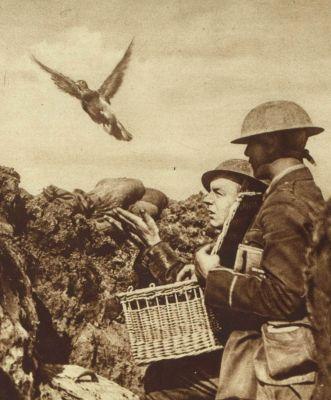Doves are often associated with the concept of Peace and Pacifism. You see them in political cartoons, on banners and signs at events promoting Peace. On the frontline in the First World War these birds were used extensively by both sides, Allied and German, to carry messages from the trenches to their respective military headquarters. Approximately a 100.000 carrier pigeons were used by the British, French, American and German military.
In Christian iconography the dove also symbolizes the Holy Spirit and early Christians in Rome accompanied their funerals with pictures of a dove carrying an olive branch and the the word ‘Peace’. The Peace Dove gets abundant exposure inside the Peace Palace building, and its image usually highlights the many activities organized by the Peace Palace Library and Peace Palace Carnegie Foundation. White ‘peace’ doves are domesticated wild rock pigeons. These rock pigeons were and are -still today- trained as homing pigeons and used by enthusiasts in racing events. With their ‘almost’ built in compass they have an innate ability to read the magnetic field of the Earth that enables them to locate their ‘home’ loft quite easily.
In our modern world with its unlimited communication possibilities via Internet, using mobile phone, laptop computer, or tablet it is hard to imagine that hundred years ago communications by telephone or telegraph were still in a crude and unreliable state. Therefore, in those days, homing pigeons or rock pigeons selectively bred for their ability to home over long distances, have served humans in times of war as war pigeons. On the frontline in the First World War these birds were used extensively by both sides, Allied and German, to carry messages from the trenches to their respective military headquarters. Approximately a 100.000 carrier pigeons were used by the British, French, American and German military.
In those days, under war conditions, among orderlies on motorcycle or horse-back, trained messenger dogs and human runners in the trenches, carrier pigeons were often significantly more accurate in delivering their handwritten messages. They proved to be an extremely reliable way of sending messages. Research indicates a 95% success rate of delivering the message to its destination. Pigeons flew high and fast and easily avoided gunfire and shrapnel and their homing device almost never failed.
These wonderful, often exceptional brave birds have been awarded many war medals to honor them for their services to humanity. For example homing pigeon, Cher Ami, donated by British pigeon fanciers to the U.S. Army Signal Corps, received the French Croix de guerre with a palm Oak Leaf Cluster for her heroic service in delivering 12 important messages in Verdun. In Cher Ami’s last mission, despite being wounded, she delivered Major Charles Whittlesey’s desperate message, hereby contributing to the rescue of the so-called ‘Lost Battalion’ (more than 500 American soldiers, left behind enemy lines, 194 survivors, October 1918). With this feat Cher Ami became the hero of the U.S. 77th Infantry Division. Having been shot through the breast, blinded in one eye, covered in blood, with a leg hanging only by a tendon, American Army medics worked long and hard to save her life. They were unable to save her leg, so they carved a small wooden one for her. When she recovered enough to travel, the now one-legged bird was put on a boat to the United States, with General John J. Pershing, commander of the American Expeditionary Forces, personally seeing Cher Ami off as she departed France. Known by many American schoolchildren of the 1920’s and 1930’s Cher Ami became a World War One war hero. After her death in 1931, she was mounted by a taxidermist and enshrined in the Smithsonian Institution.
- Garner, J.W., International Law and the World War, 2 vols., London, Longmans, Green and Co, 1920.
- Hankel, G., Die Leipziger Prozesse: Deutsche Kriegsverbrechen und ihre strafrechtliche Verfolgung nach dem Ersten Weltkrieg, Hamburg, Hamburger Edition, 2003.
- Hirschfeld, G., G. Krumeich and I. Renz (eds.), Brill’s Encyclopedia of the First World War, Leiden, Brill, 2012.
- Hirschfeld, G. und G. Krumeich (Hrsg.), Enzyklopädie Erster Weltkrieg, Paderborn, Schöningh, 2014.
- Horne, J.N. and A.R. Kramer, German Atrocities, 1914: A History of Denial, New Haven, Yale University Press, 2001.
- Joll, J.B., The Origins of the First World War, Harlow, Longman, 1984.
- MacMillan, M.O., The War that ended Peace: How Europe abandoned Peace for the First World War, London, Profile Books, 2013.
- Münkler, H., Der Große Krieg: die Welt 1914 bis 1918, Berlin, Rowohlt, 2013.
- Phillipson, C., International Law and the Great War, London, Fisher Unwin; Sweet and Maxwell, 1915.
- Pöhlmann, M., J.S. Corum and G. Hirschfeld (eds.), Brill’s Encyclopedia of the First World War, Leiden, Brill, 2012.
- Stevenson, D., 1914-1918: the History of the First World War, London, Penguin, 2005.
- Storey, W.K., The First World War: a Concise Global History, Lanham, MD, Rowman & Littlefield, 2009.
